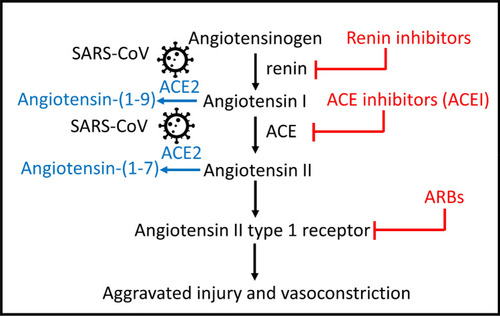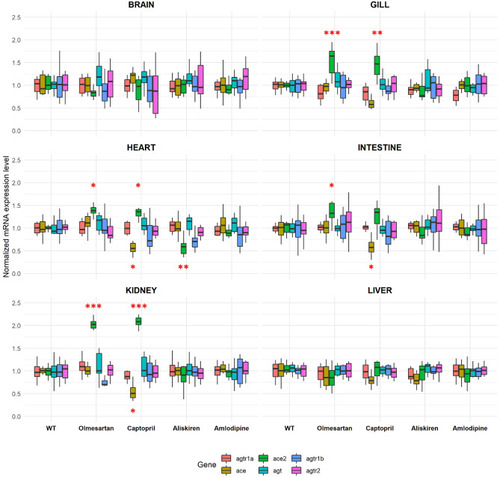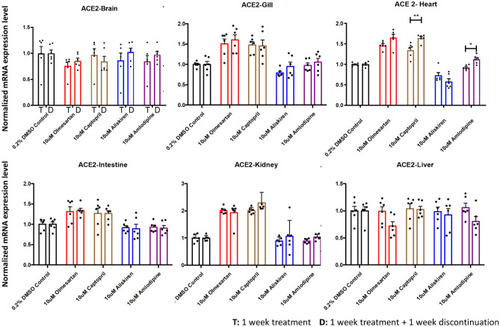- Title
-
The effect of renin-angiotensin-aldosterone system inhibitors on organ-specific ace2 expression in zebrafish and its implications for COVID-19
- Authors
- Kim, G.J., Melgoza, A., Jiang, F., Guo, S.
- Source
- Full text @ Sci. Rep.
|
The RAAS pathway and its relationship to SARS-CoV(1 and 2) viruses. Upon entry to cells, the SARS-CoV is known to bind to its functional receptor, angiotensin converting enzyme 2 (ACE2). In normal physiology, renin cleaves angiotensinogen, produced by the liver which yields angiotensin I. The angiotensin converting enzyme (ACE) converts angiotensin I to angiotensin II and the angiotensin II binds to the angiotensin II type 1 receptor which leads to vasoconstriction, aggravated tissue injury and hormonal production. ACE2 cleaves angiotensin II into angiotensin (1–7) to attenuate the effects of vasoconstriction. Another function of ACE2 involves cleaving angiotensin I to angiotensin-(1–9) for the hydrolysis of peptides such as apelin-1. Aliskiren is a direct renin inhibitor that blocks the conversion of angiotensinogen to angiotensin I. Captopril is an ACE-I that blocks the conversion of angiotensin I to angiotensin II. Olmesartan is an ARB ACE-I: Angiotensin Converting Enzyme Inhibitor, ARB: Angiotensin Receptor Blocker, ACE: Angiotensin Converting Enzyme-1, ACE2: Angiotensin Converting Enzyme-2. |
|
A schematic diagram for the experimental design for drug treatment and discontinuation. To determine mRNA expression of RAAS genes following one week of chronic antihypertensive drug administration, Group 1 consisted of zebrafish that were treated with 0.2% DMSO (control), aliskiren, olmesartan, captopril, and amlodipine daily for 7 days, then dissected for qRT-PCR analysis. Additionally, Group 2 consisted of zebrafish that were treated identically as Group 1 for 7 days, but then drug administration was discontinued for 7 more days before dissection and qRT-PCR analysis. The extracted organs include the brain, kidney, intestine, gill, liver, and heart. Six biological replicates (3 males and 3 females) were used for each compound (or vehicle) in each group. |
|
RAAS pathway gene expression displays tissue-specific enrichment. The relative expression levels of agtr1a, ace, ace2, agt, agtr1b, and agtr2 to elf1a1 in different organs of wild type adult zebrafish (n = 6). agt: Angiotensinogen, agtr1b: Type-1B angiotensin II receptor, agtr2: Type-2 Angiotensin II Receptor, agtr1a: Type-1A angiotensin II receptor, ace: Angiotensin-converting enzyme 1, ace2: Angiotensin-converting enzyme 2. |
|
Tissue-specific up-regulation of ace2 expression by RAAS inhibitors. The ace2 expression was significantly increased in captopril and olmesartan treated groups compared to the DMSO control in the gill, heart, and kidney (n = 6 per gene-organ-drug combination, *p < 0.05, **p < 0.01, ***p < 0.001 unpaired t test). Olmesartan also increased ace2 expression in the intestine (n = 6, p < 0.05, unpaired t test). Aliskiren treatment significantly decreased the ace2 expression in the heart; captopril treatment decreased ace expression in the heart, intestine, and the kidney (n = 6, p < 0.05, unpaired t test). Olm: olmesartan, Cap: captopril, Ali: aliskiren, Amlo: amlodipine. |
|
Comparison of ace2 expression levels between treatment and discontinuation. The expression levels were compaired between the 1-week treatment group and 1-week treatment plus 1-week discontinuation group for different organs. The captopril and amlodipine treatment increased ace2 mRNA expression in the heart 7 days after discontinuation compared to 7-day treatment (n = 6 per group; *p < 0.05, **p < 0.01, unpaired t test). Other organs showed no significant difference between treatment and discontinuation. T: 1 week treatment D: 1 week treatment + 1 week discontinuation. |





